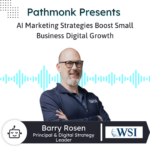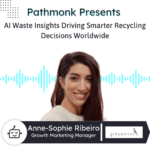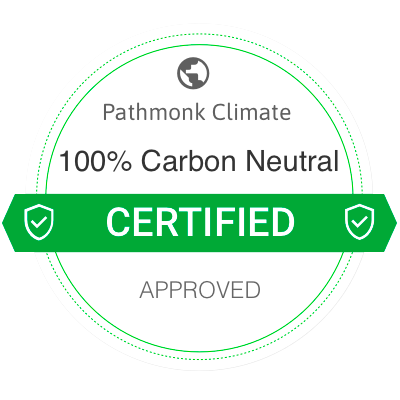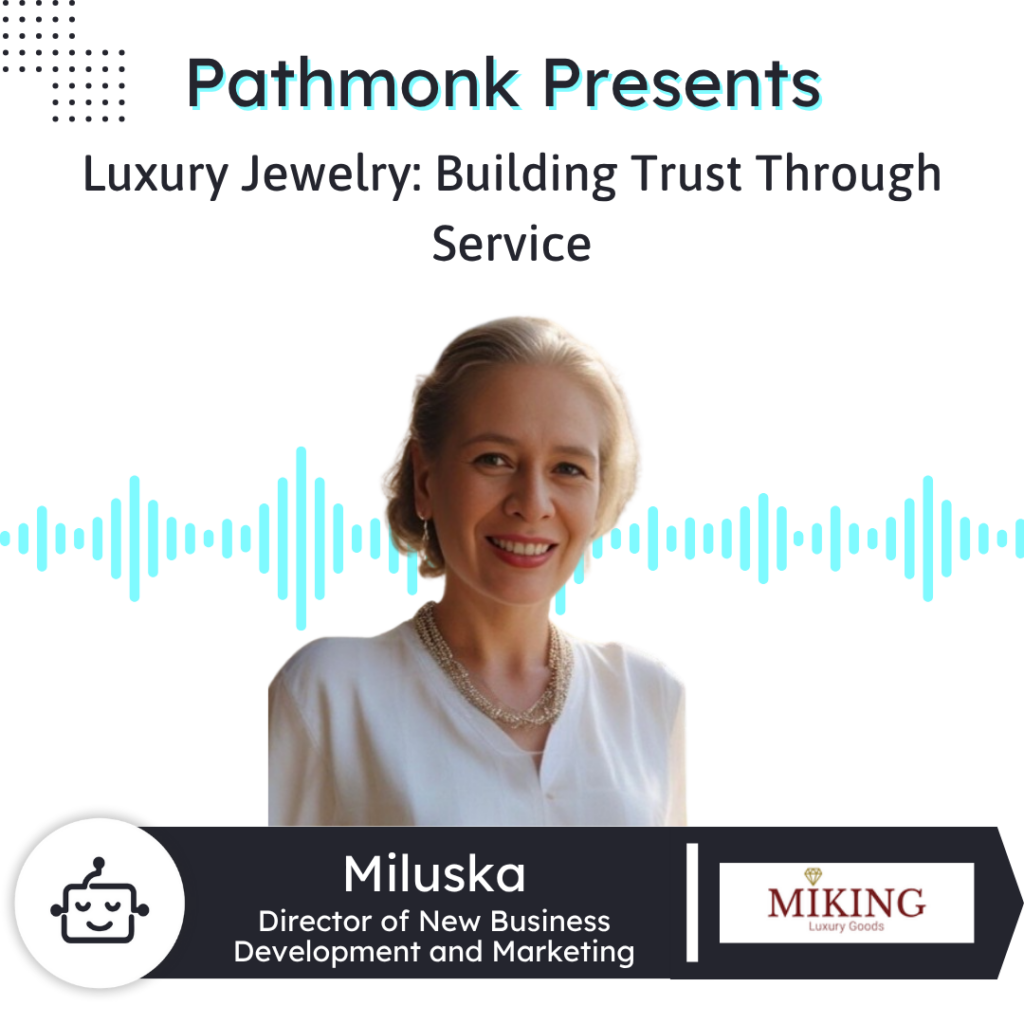
Introduction
Miluska Ochoa, Director of New Business Development and Marketing at Miking, joins Pathmonk Presents to discuss their luxury goods brand specializing in loose diamonds, fine jewelry, and artisan craftsmanship.
Miking serves global B2C and B2B clients, emphasizing personalized customer service and trust-building.
Miluska highlights their website’s role as a catalog and tool for virtual try-ons, enhancing customer engagement. By offering tailored solutions and fostering emotional connections, Miking drives repeat business and supports partners in growing their jewelry businesses worldwide.
Increase +180%
leads
demos
sales
bookings
from your website with AI
Get more conversions from your existing website traffic delivering personalized experiences.
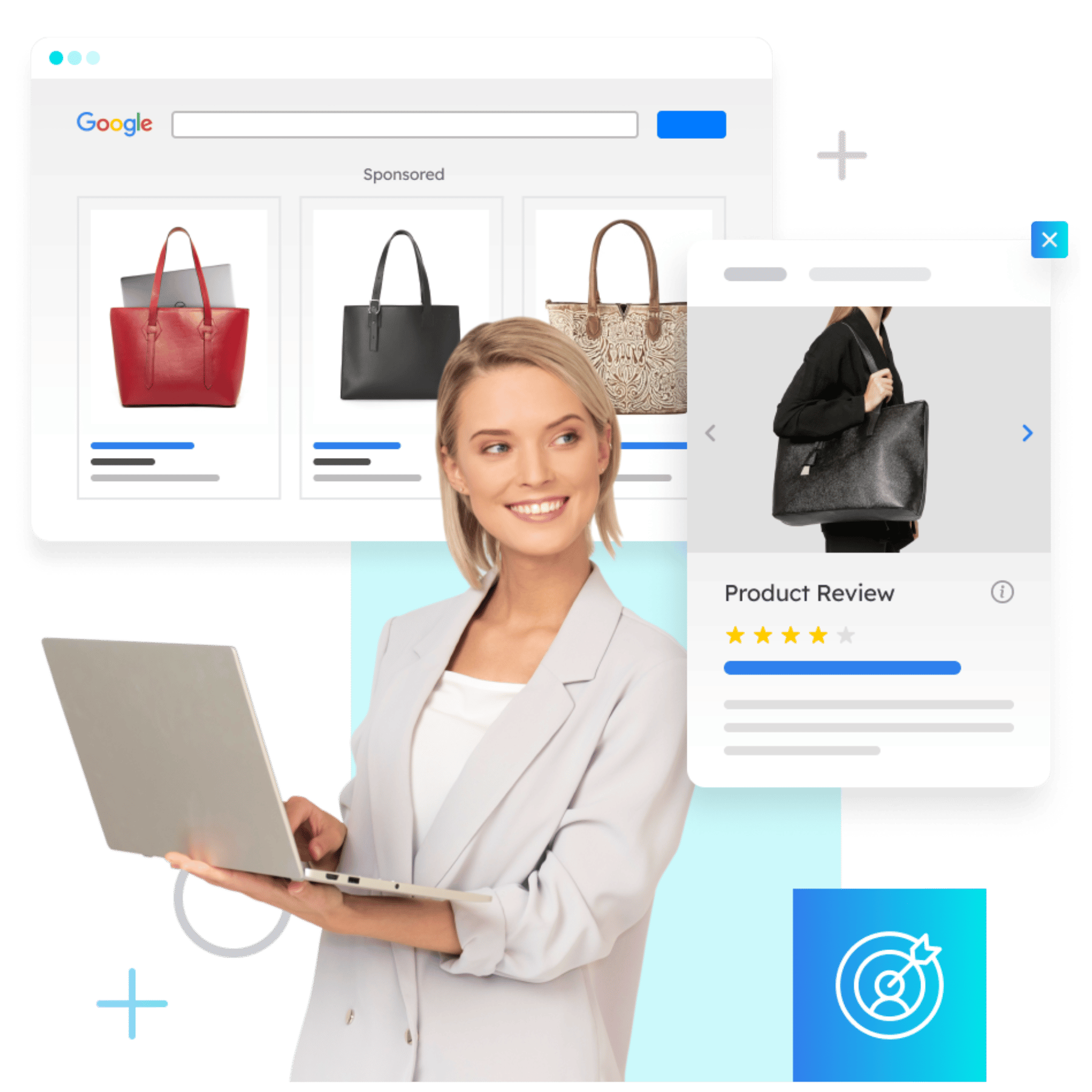
Rick: Pathmonk is the AI for website conversions. With increasing online competition, over 98% of website visitors don’t convert. The ability to successfully show your value proposition and support visitors in the buying journey separates you from the online competition. Pathmonk qualifies and converts leads on your website by figuring out where they are in the buying journey and influencing them in key decision moments with relevant micro experiences like case studies, intro videos, and much more.
Stay relevant to your visitors and increase conversions by 50% by adding Pathmonk to your website in seconds. Let the artificial intelligence do all the work while you continue marketing as usual. Check us out on Pathmonk.com. Welcome to today’s episode of Pathmonk Presents.
Today we are joined by Miluska. She’s the Director of New Business Development and Marketing at Miking. Miluska, welcome to the show.
Miluska: Thank you, thank you.
Rick: Of course. We’re excited to have you here. We just want to jump right into it. Miluska, if you don’t mind talking about what’s at the heart of what your company does, how would you describe it to someone new?
Miluska: Yes, Miking is a luxury goods company. We have a portfolio of products and services. In products, we have our core product: loose diamonds, loose gemstones, and also loose pearls. Then we have fine jewelry in 10 karat gold. We also have other markets with 14 and 10 karat gold, even red gold. But our main focus is loose diamonds and fine jewelry.
We do have a facility in Peru where we manufacture the product. It’s not machine-made; it’s more artisan—high jewelry. We also invest in therapy—essential oils and jewelry for therapy. We did that during COVID because we wanted to offer something different. It worked very well.
Focusing again on products, we also manage accessories, and right now we are in a new project with home accessories. This will likely be ready by the end of the year, to be sold in spring/summer next year. We need to test it first.
In terms of services, we also serve B2B clients—fashion designers and jewelry companies. We support them with all the tools we can because we believe it’s not just about selling; it’s about supporting the market and the industry. We don’t just help them—we partner with them. You grow, we grow, and everyone grows.
Our services range from shipping to marketing. This is what we are doing right now. Education came into the picture because some clients needed to train their people, and we have the tools for that. It’s important since we serve globally, and now, with virtual tools, we actually can do it globally.
Rick: That’s very interesting. Let’s touch on that for a second. You serve globally. What kind of customers are the best fit for your product? What kind of experience can they expect when they shop from you or interact with you? Even in partnerships, what’s your ethos?
Miluska: Yes, we have both B2C and B2B customers.
For B2C, we try to be very attentive. End users like to feel special and get attention, maybe even some gifts. That’s why they pay a bit more—for the experience. We try to focus on what they need. For example, we offer great packaging and customer service. If they want a note included, we do that. A happy customer will come back and buy more.
Here’s an example. A customer once purchased a diamond watch. But something happened—she wasn’t sure it was the one she wanted. She told us, “I thought it was this one, but I want the other.” We told her, “Don’t worry. Let’s work together.” We offered her another watch for free if she continued with the sale because we wanted her to feel valued. High-end customers value relationships. If she’s happy, her daughter, her son, a relative will buy from us too.
In B2B, the approach is different but equally intensive. For example, a jewelry company wanted to pass the business from father to son. The son had been in Australia running another business. The father told us, “If he doesn’t want to continue, we might sell the company.” So we partnered with them. We researched market opportunities, trained the son in six months, and now he’s successfully running the business, attending shows, negotiating, and growing the brand.
This is how we build trust and relationships. We don’t just talk price—we offer solutions. We even have a database of trusted companies to refer clients to, whether it’s for shipping, marketing, or something else.
Rick: The theme I see here is attention to detail. From offering a free watch to helping a family transition a business—that speaks volumes about how you care for people and build real connections. I’m sure you get a lot of word-of-mouth business from that.
Now let’s talk about your website. I’m assuming it’s a big part of your e-commerce strategy. Is that true? How crucial is your website, and what are some of the strengths or improvements you’ve made?
Miluska: Yes, absolutely. We work on it every single day. There are translators, editors, technical engineers checking the code. The website is more than a platform—it’s a place to give information to customers. And now, search engines like Google require more and more technical quality—like SEO audits.
We expect to launch our new website in September, and we’ll begin testing it in July. We’ve spent about two years trying to get virtual try-on features. We’ve tested 2D, 3D, and 360 technologies with companies worldwide. Every company has its own touch, and we even recommend some of them to our clients.
With the new website, we want customers to be able to build their own products, not just choose from inventory. It’s especially important for fine jewelry—like engagement rings and wedding rings.
The new site will follow 2025 trends: more video, faster performance, better SEO, and inclusive design—for people with limited vision or low bandwidth. We’re also improving accessibility.
We had a customer from Canada, originally from Morocco, excited to open a new store. He saw the site and asked, “How can you help?” We said, “Tell us your dream and we’ll try to make it real.” Depending on the purchase volume, we even include some services in the product price.
We use the site like a catalog. While it shows a limited range of diamonds, we have many more. If they say, “I want what you don’t have,” we say, “Don’t worry—we do have it, it’s just not online yet.”
A lot of our clients don’t even have a website. They send pictures manually. So there’s a big opportunity. We’re not trying to compete with top web development agencies. Our goal is to help clients—like that Canadian entrepreneur—who don’t have a marketing team. We give them a site, social media assets, and advice to get them started.
Of course, our core business is selling products, not services—but we offer support because a good website helps us all.
Rick: That’s a great point. I must agree—our company works with websites too, helping increase conversions. So we see a lot of them. You can treat a website as a catalog or as an extended experience if you also have retail stores. But what’s important is to have one in the first place. That’s how people get to know you and interact with your brand.
As we near the end of the show, let’s move into our rapid-fire question segment. It’s a light way to wrap things up. The only rule is: concise questions get concise answers. Sound good?
Miluska: Sure, yes.
Rick: Okay, let’s do it. Would you prefer watching, reading, or listening?
Miluska: Reading.
Rick: What’s the latest book or article you picked up? Any gems or ideas that really stuck with you?
Miluska: Introduction to Philosophy. I love reading about Socrates—thinking again about life, happiness, and the meaning of words. Now that I have more time, I try to read at least an hour a day.
Rick: That’s good. Sounds like a heavy read that really makes you think. Socrates was a great philosopher.
Maybe not as deep, but here’s my next question: if you had a magic wand and could fix one frustrating thing in your marketing life with tech, what would it be?
Miluska: That’s a big question. I think it’s more about people’s happiness. Right now, people feel lonely even though they’re globally connected. I’m working on a human avatar project, and it makes me think a lot about how not to lose the human touch.
That’s the challenge of marketing in the future—with AI. I tell young people not to be scared of AI taking their jobs. Nothing will replace humans. We are soul, body, and spirit. Emotions matter. Even if you create an avatar that looks and talks like you, it’s still not real.
If I could fix something, it would be: don’t try to replace being human. You won’t succeed in marketing—or anything else—if you lose the essence of being human. Technology can help. Pacemakers, exoskeletons—they help us live. But they don’t replace the feelings you get from petting your dog or cat, from sharing a peanut. That emotional connection is irreplaceable.
Respect nature, respect animals, and don’t destroy what you’re trying to achieve in the name of science. Marketing is a science, yes—but it shouldn’t destroy what matters.
Rick: Yeah, that’s a great way to close—with some wisdom from you, Miluska. We really appreciate it.
Where can people find you if they want fine jewelry or diamonds or to work with you?
Miluska: They can go to miking.us—M-I-K-I-N-G dot US. They can also find us on the GIA website, gia.edu. If they search for Miami Airport or Lima, Peru, they’ll find Miking LLC there. We’re registered with the GIA, and I always promote it.
Rick: Amazing. It was a great conversation. We appreciate you being with us, and maybe we’ll do this again before the year ends. Hope to see you again soon.
Miluska: Thank you. It’ll be my pleasure. I loved it. Thank you so much.
Rick: All right. Bye, everyone.




